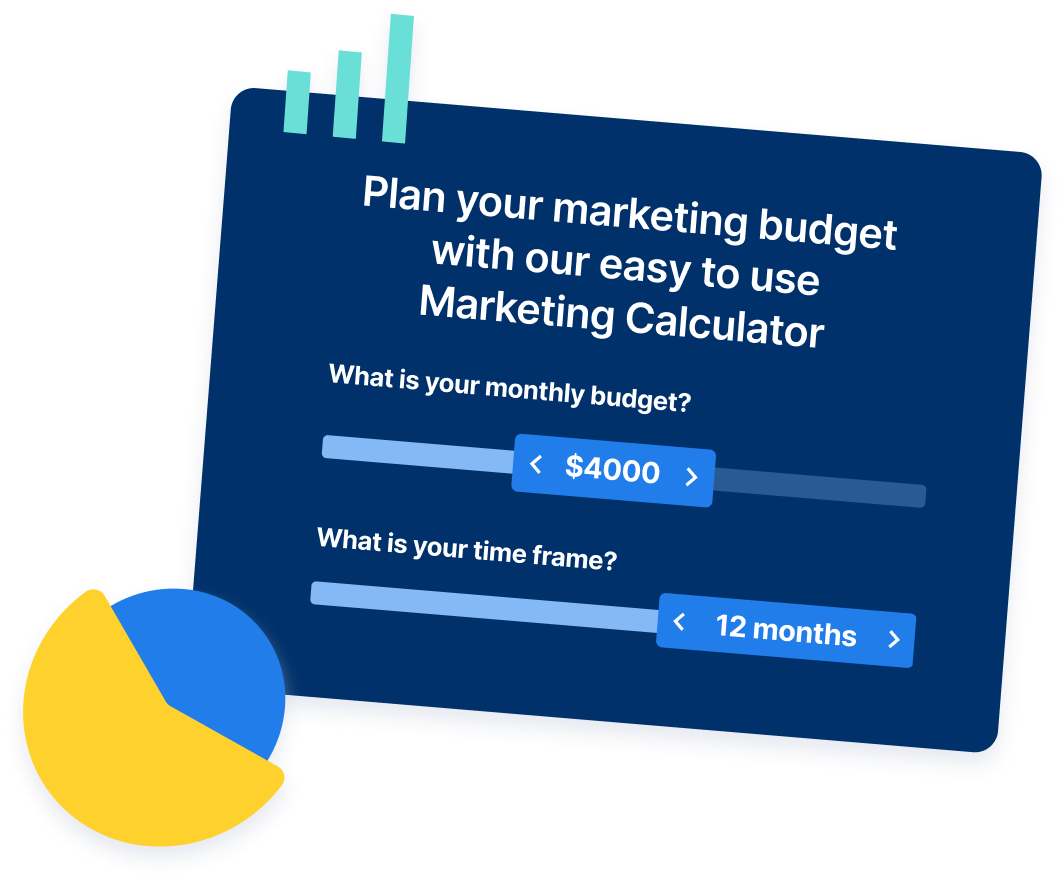-
 Published: Apr 7, 2025
Published: Apr 7, 2025
-
 7 min. read
7 min. read
-
 Lornah Ngugi
Lornah Ngugi Marketing Writer
Marketing Writer
- Lornah is a marketing writer with over six years of experience and a knack for writing unique and compelling content for a wide variety of topics in diverse industries. She has written over 400 posts for WebFX clients spanning tech, manufacturing, professional services, and other industries. She likes to start her days with a quiet outdoor walk in the park followed by a perfectly brewed cup of black coffee. There’s nothing a chocolate bar can’t fix for Lornah, from a bad mood to writer’s block.
Businesses in most industries can expect to earn at least $5 of revenue for every $1 spent on marketing. With the right digital marketing services provider and strategies in place, this can be as high as $10 for every $1 spent.
You’re more likely to achieve these marketing revenue targets if you already invest the recommended 7-8% of your total revenue for small businesses and 10% for midsized companies into marketing efforts.
Revenue marketing is the digital marketing approach geared toward driving revenue for businesses through marketing. It involves creating every campaign and piece of content with the goal of generating measurable business value and boosting your marketing return on investment (ROI).
Below, we break down how much revenue marketing should generate by defining marketing-generated revenue and the key metrics to track.
What is marketing-generated revenue?
Marketing-generated revenue refers to the income earned directly from your marketing efforts. It justifies your marketing spending to help align your marketing campaigns with your budget, allocate resources more effectively, and achieve your marketing goals.
Revenue marketing successfully boosts your ROI by aligning marketing and sales teams to maximize your marketing budget. When all your marketing activities are revenue-focused, they address customers’ specific needs and pain points to ensure customer satisfaction and drive repeat business.
You can track and measure marketing-sourced revenue by reviewing leads, conversions, and sales you gain from different marketing channels, like content marketing or digital advertising. This helps you understand which efforts, channels, and platforms are contributing the most or the least to your revenue growth.
You can break down marketing-generated revenue into numerous categories:
- Predicted revenue: This is the amount of revenue you expect to generate when you deduct estimated expenses. Revenue marketing aligns sales and marketing to help organizations reach predicted revenue and maximize their investments.
- Annual recurring revenue (ARR): The ARR accounts for the total amount of revenue you can earn from contracts and subscriptions minus one-time payments. Marketing drives ARR growth by acquiring new subscribers, upselling or cross-selling existing subscribers, and minimizing churn rates.
- Monthly recurring revenue (MRR): It indicates how much income to expect per month, and it helps you identify seasonal revenue trends and the impact of specific marketing campaigns and strategies in the short term.
Key marketing revenue metrics to track
You can measure marketing revenue by tracking and measuring some specific metrics that provide insight into the profitability of your marketing campaigns. It also helps you understand how efficiently and effectively your marketing budget is spent and find ways to maximize revenue generation.
The following are the top three revenue marketing metrics or key performance indicators (KPIs) you need to help you predict and calculate marketing-generated revenue:
1. Return on investment (ROI)
Marketing ROI is a measure of how much profit your marketing activities generate relative to your investment.

Measuring ROI helps you differentiate your total marketing revenue and actual profits. It enables you to determine the right platforms to invest your marketing budget and how to gain a competitive advantage.
Marketing ROI varies based on marketing campaigns and businesses, with a good ROI ratio being 5:1 and an excellent ROI being 10:1. These ratios mean that for every dollar spent on marketing, you earn 5 and ten dollars, respectively.
The ratios vary extensively between different types of digital marketing strategies and campaigns, with email marketing being among the highest revenue drivers with an ROI of 44:1.
2. Return on ad spend (ROAS)
Marketing ROAS is a measure of the revenue earned from your digital advertising strategies, campaigns, and ad groups. It’s a key metric to compare with other revenue-measuring metrics to determine how to improve your ad strategies and monetary returns.

ROAS helps you increase your revenue by justifying ad spending with the number of leads and sales you can expect. It also provides insights into the ads that are effectively driving the most revenue. Ideally, your ads should generate an average of $2 revenue for every $1 ad cost, making the average ROAS 2:1, but a good ROAS is 4:1.
For example, when you spend $500 to run Google ads for your coffee shop’s new seasonal latte and generate $1500 in revenue from the seasonal latte sales, your ROAS IS 3:1, which is considered an above-average return on ad spend.
Calculate Your ROAS With Our Free Calculator
3. Customer lifetime value (CLV)
Marketing CLV is a metric that shows the amount of revenue you expect to generate in the duration of a customer’s relationship with your company. Calculating CLV provides you with insight into the long-term value of using part of your marketing budget to acquire and retain customers.

An increasing CLV indicates that your customers are satisfied with your offerings, your churn rates are low, and you’re likely to earn more revenue from them. A high CLV can save you up to 10 times because it costs about that much to acquire a new customer as compared to retaining an existing one.
For example, say you have a customer who buys a cup of coffee for $5 daily for six days a week. Here’s a break down into how they drive higher revenue for you:
- Weekly spend: $5 * 6 days = $30
- Yearly spend: $30 * 52 weeks = $1560
Now let’s assume this loyal coffee lover remains a customer for 5 years.
- Customer lifetime value: $1560 * 5 years = $7800
Finally, let’s say you spent $20 on the ad that converted this customer, which means that $20 resulted in $7,800 in revenue.
FAQs about marketing revenue
Here are some answers to some of the most commonly asked questions about marketing revenue.
What’s the difference between marketing-generated revenue and overall company revenue?
Marketing-generated revenue is financial value directly tied to marketing activities like social media marketing or search engine optimization (SEO). However, overall company revenue is the total income a company generates from its core business operations, such as selling products or services.
What’s a realistic ROI for marketing campaigns?
Generally, most businesses can expect an ROI of $5 of revenue for every $1 spent on digital marketing. It’s possible to achieve an ROI ratio of 10:1 if you set the right ROI goals and focus on high-performing channels and the metrics that matter.
Should I use ROAS or ROI?
It’s best to analyze both ROAS and ROI to determine marketing revenue margins. ROAS will offer an average return on your advertising investment, while ROI will provide a clear view of your total return value from your paid and unpaid marketing campaigns.
Furthermore, ROAS is great for measuring short-term profitability, goals, and campaign results, while ROI helps track long-term profitability.
Get data-driven revenue marketing services from WebFX
Are you looking to grow your business revenue through marketing? Partnering with a leading professional digital marketing service provider like WebFX will help you achieve your revenue goals.
WebFX is a full-service digital marketing firm that leverages data, award-winning expertise, and innovative technology to drive business revenue. Our approach has enabled us to generate over $10 billion in revenue for our clients. We help our clients see a 20% average increase in ROI with our custom marketing campaigns.
Our clients get access to RevenueCloudFX, our smart marketing technology that helps you track, measure, and activate your marketing results to drive revenue. RevenueCloudFX empowers you with actionable analytics that empower not only your marketing team but also your sales team to close more marketing-generated leads, achieving higher revenue.
Request a free proposal today, or call us at 888-601-5359 to speak to a strategist about how we can help you increase your marketing-generated revenue.
-
 Lornah is a marketing writer with over six years of experience and a knack for writing unique and compelling content for a wide variety of topics in diverse industries. She has written over 400 posts for WebFX clients spanning tech, manufacturing, professional services, and other industries. She likes to start her days with a quiet outdoor walk in the park followed by a perfectly brewed cup of black coffee. There’s nothing a chocolate bar can’t fix for Lornah, from a bad mood to writer’s block.
Lornah is a marketing writer with over six years of experience and a knack for writing unique and compelling content for a wide variety of topics in diverse industries. She has written over 400 posts for WebFX clients spanning tech, manufacturing, professional services, and other industries. She likes to start her days with a quiet outdoor walk in the park followed by a perfectly brewed cup of black coffee. There’s nothing a chocolate bar can’t fix for Lornah, from a bad mood to writer’s block. -

WebFX is a full-service marketing agency with 1,100+ client reviews and a 4.9-star rating on Clutch! Find out how our expert team and revenue-accelerating tech can drive results for you! Learn more
Try our free Marketing Calculator
Craft a tailored online marketing strategy! Utilize our free Internet marketing calculator for a custom plan based on your location, reach, timeframe, and budget.
Plan Your Marketing Budget
Table of Contents
- What is Marketing-generated Revenue?
- Key Marketing Revenue Metrics to Track
- 1. Return on Investment (ROI)
- 2. Return on Ad Spend (ROAS)
- 3. Customer Lifetime Value (CLV)
- FAQs About Marketing Revenue
- What's the Difference Between Marketing-generated Revenue and Overall Company Revenue?
- What's a Realistic ROI for Marketing Campaigns?
- Should I Use ROAS or ROI?
- Get Data-driven Revenue Marketing Services from WebFX

Proven Marketing Strategies

Proven Marketing Strategies
Try our free Marketing Calculator
Craft a tailored online marketing strategy! Utilize our free Internet marketing calculator for a custom plan based on your location, reach, timeframe, and budget.
Plan Your Marketing Budget





